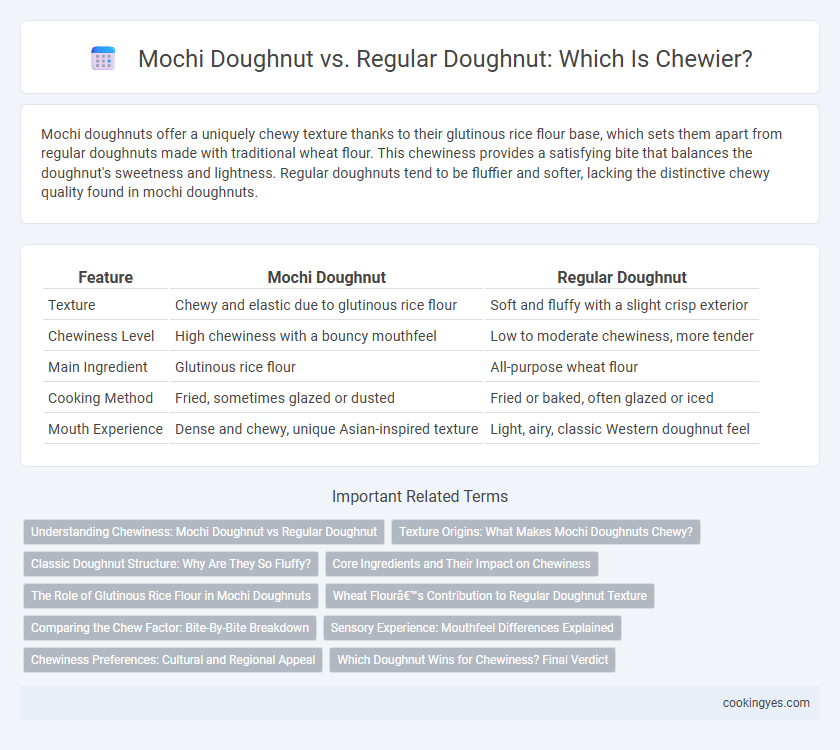Mochi doughnuts offer a uniquely chewy texture thanks to their glutinous rice flour base, which sets them apart from regular doughnuts made with traditional wheat flour. This chewiness provides a satisfying bite that balances the doughnut's sweetness and lightness. Regular doughnuts tend to be fluffier and softer, lacking the distinctive chewy quality found in mochi doughnuts.
Table of Comparison
| Feature | Mochi Doughnut | Regular Doughnut |
|---|---|---|
| Texture | Chewy and elastic due to glutinous rice flour | Soft and fluffy with a slight crisp exterior |
| Chewiness Level | High chewiness with a bouncy mouthfeel | Low to moderate chewiness, more tender |
| Main Ingredient | Glutinous rice flour | All-purpose wheat flour |
| Cooking Method | Fried, sometimes glazed or dusted | Fried or baked, often glazed or iced |
| Mouth Experience | Dense and chewy, unique Asian-inspired texture | Light, airy, classic Western doughnut feel |
Understanding Chewiness: Mochi Doughnut vs Regular Doughnut
Mochi doughnuts exhibit a unique chewiness due to their glutinous rice flour base, which creates a dense and stretchy texture unlike the airy and soft crumb of regular doughnuts made from wheat flour. This chewiness is attributed to the molecular structure of mochi's starch chains, providing a resilient bite that contrasts with the tender, crumbly texture of traditional deep-fried doughnuts. Understanding chewiness in these doughnuts involves comparing the starch composition and moisture retention properties that influence their mouthfeel and overall eating experience.
Texture Origins: What Makes Mochi Doughnuts Chewy?
Mochi doughnuts achieve their distinctive chewiness through the use of glutinous rice flour, which contains high amounts of amylopectin starch, creating a dense and elastic texture unlike the airy crumb of regular doughnuts made from wheat flour. This unique ingredient alters the molecular structure during frying, resulting in a stretchy, mochi-like bite that contrasts with the soft, fluffy texture typical of traditional yeast or cake doughnuts. The texture origins lie in the starch composition and gluten absence in mochi doughnuts, which fundamentally changes their chewiness and mouthfeel.
Classic Doughnut Structure: Why Are They So Fluffy?
Classic doughnuts owe their fluffy texture to a well-developed gluten network and yeast fermentation, which produce air pockets during proofing and frying. Mochi doughnuts, however, incorporate glutinous rice flour, resulting in a denser, chewier bite due to their unique starch composition. This contrast highlights how traditional doughnut structure emphasizes lightness while mochi doughnuts prioritize a distinctive, chewy mouthfeel.
Core Ingredients and Their Impact on Chewiness
Mochi doughnuts achieve their distinctive chewiness primarily through glutinous rice flour, which contains high amylopectin content that gives the dough its elastic and sticky texture. In contrast, regular doughnuts rely on wheat flour with gluten proteins, producing a softer, more airy crumb with less chew. The core ingredient differences directly impact the mouthfeel, with mochi doughnuts offering a denser, more resilient bite compared to the lightness of traditional doughnuts.
The Role of Glutinous Rice Flour in Mochi Doughnuts
Glutinous rice flour in mochi doughnuts significantly enhances chewiness by providing a dense, elastic texture distinct from the airy, soft crumb of regular doughnuts made with wheat flour. This flour's high amylopectin content contributes to a sticky, stretchy consistency, creating a unique mouthfeel that contrasts with the typical fluffiness associated with traditional doughnuts. Consequently, mochi doughnuts offer a more resilient bite, appealing to consumers seeking a chewy and satisfying dessert experience.
Wheat Flour’s Contribution to Regular Doughnut Texture
Wheat flour plays a crucial role in the chewy texture of regular doughnuts by developing gluten networks that provide elasticity and structure. Unlike mochi doughnuts, which rely on glutinous rice flour for a soft, stretchy bite, regular doughnuts achieve their characteristic chewiness through the protein content in wheat flour. This gluten formation enhances the doughnut's resilience and creates a distinct mouthfeel that differentiates it from the light and airy texture of mochi doughnuts.
Comparing the Chew Factor: Bite-By-Bite Breakdown
Mochi doughnuts offer a uniquely chewy texture due to their glutinous rice flour base, creating a soft yet resilient bite contrasted with the airy, cake-like softness of regular doughnuts. Each bite of a mochi doughnut delivers a stretchy, satisfying chew that holds its shape longer, whereas regular doughnuts provide a lighter, melt-in-your-mouth experience with less resistance. This difference in chewiness highlights mochi doughnuts as a distinct choice for those seeking a more substantial, springy texture compared to the traditional doughnut's fluffiness.
Sensory Experience: Mouthfeel Differences Explained
Mochi doughnuts offer a unique chewiness derived from glutinous rice flour, creating a bouncy, elastic texture that contrasts sharply with the soft, airy crumb of regular doughnuts made from wheat flour. The sensory experience highlights mochi doughnuts' springy bite and subtle resistance, enhancing mouthfeel complexity compared to the fluffy, melt-in-the-mouth sensation of traditional doughnuts. This difference in texture profoundly influences consumer perception, making mochi doughnuts especially appealing for those seeking a satisfying, chewy treat.
Chewiness Preferences: Cultural and Regional Appeal
Mochi doughnuts offer a distinct chewiness due to their glutinous rice flour base, appealing strongly to East Asian taste preferences where a chewy texture is prized. Regular doughnuts, made from wheat flour and often fried until light and airy, cater more to Western preferences favoring softness and fluffiness. Regional variations influence chewiness preferences, with mochi doughnuts gaining popularity in urban areas seeking unique textures, while traditional doughnuts remain favored in regions valuing classic pastries.
Which Doughnut Wins for Chewiness? Final Verdict
Mochi doughnuts outperform regular doughnuts in chewiness due to their use of glutinous rice flour, which gives them a uniquely elastic texture compared to the soft, airy crumb of traditional wheat-based doughnuts. The molecular structure of mochi doughnuts creates a springy bite that retains moisture longer, enhancing chewiness significantly. For those prioritizing a chewy texture, the mochi doughnut is the definitive winner over its regular counterpart.
Mochi doughnut vs Regular doughnut for chewiness Infographic

 cookingyes.com
cookingyes.com